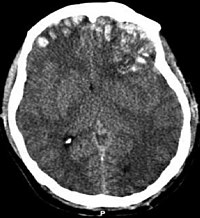
Photo from wikipedia
Objective The aim of this study is to examine the effect of eight distinct marginalized group memberships and explore their compounding effect on injury severity, recovery, discharge location, and employment… Click to show full abstract
Objective The aim of this study is to examine the effect of eight distinct marginalized group memberships and explore their compounding effect on injury severity, recovery, discharge location, and employment outcomes 1-year after traumatic brain injury (TBI). Methods Individuals with medically confirmed, complicated mild-severe TBI (N = 300) requiring inpatient rehabilitation care between the ages of 18 and 65 were recruited at two urban (public and private) health systems between 2013 and 2019. Data were collected from self-report and medical record abstraction. Marginalized group membership (MGM) includes racial and ethnic minority status, less than a high school diploma/GED, limited English proficiency, substance abuse, homelessness, psychiatric hospitalizations, psychiatric disorders, and incarceration history. Membership in four or more of these groups signifies high MGM. In addition, these factors were explored individually. Unadjusted and adjusted linear and logistic regressions and Kruskal–Wallis tests were used to assess the associations of interest in RStudio. Results After adjusting for age, sex, and cause of injury, compared to TBI patients with low MGM, those with high MGM experience significantly longer post-traumatic amnesia (95% CI = 2.70, 16.50; p = 0.007) and are significantly more likely to have a severe TBI (per the Glasgow-Coma Scale) (95% CI = 1.70, 6.10; p ≤ 0.001) than a complicated mild-moderate injury. Individuals with high MGM also are significantly less likely to be engaged in competitive paid employment 1 year after injury (95% CI = 2.40, 23.40; p = 0.001). Patients with high MGM are less likely to be discharged to the community compared to patients with low MGM, but this association was not significant (95% CI = 0.36, 1.16; p = 0.141). However, when assessing MGMs in isolation, certain associations were not significant in unadjusted or adjusted models. Conclusion This exploratory study's findings reveal that when four or more marginalization factors intersect, there is a compounding negative association with TBI severity, recovery, and employment outcomes. No significant association was found between high MGM and discharge location. When studied separately, individual MGMs had varying effects. Studying marginalization factors affecting individuals with TBI has critical clinical and social implications. These findings underline the importance of addressing multidimensional factors concurrent with TBI recovery, as the long-term effects of TBI can place additional burdens on individuals and their economic stability.
Journal Title: Frontiers in Neurology
Year Published: 2022
Link to full text (if available)
Share on Social Media: Sign Up to like & get
recommendations!